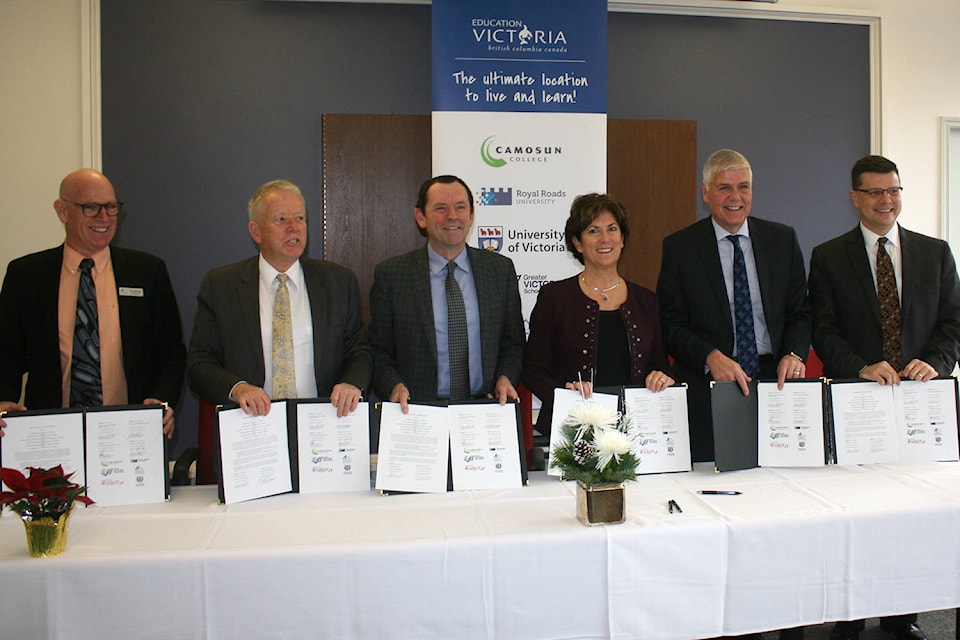Representatives of three post-secondary institutions and three local school districts have formalized an agreement that promotes the region to international students, an increasingly important part of the provincial economy and local school district budgets.
“Our focus is to have the southern Vancouver Island [region] as a destination for international students to come, learn, work and perhaps stay, after they have finished post-secondary,” said Sherri Bell, president of Camosun College.
She made those comments Monday after Allan Cahoon, president of Royal Roads University, Jamie Cassels, president and vice-chancellor of University of Victoria, Piet Langstraat, superintendent of SD 61 (Greater Victoria), Dave Eberwein, superintendent of SD 63 (Saanich), and Jim Cambridge, superintendent of SD 62 (Sooke), had joined Bell at the Lansdowne campus of Camosun College to sign the agreement.
The five-year agreement formalizes Education Victoria, an informal agreement that Camosun College, UVIC, RRU and SD 61 reached in 2013 and adds SD 62 and 63 along the way.
“It will help us co-ordinate our actions, and make sure that we are working in sync with each other rather than at cross-purposes,” said Eberwein, whose school district SD 63 includes Saanich’s Claremont secondary.
The recruitment of international students – whether they are K-12 or post-secondary students – is becoming an important part of B.C.’s economy.
Just over 130,000 international students attended provincial post-secondary institutions and K-12 schools in 2015 – a 44 per cent increase in the number of international students in B.C. from 2010, according to the British Columbia Council for International Education. This international student body spent over $3.5 billion to pay for their tuition and fees and day-to-day living expenses in 2015, according to the organization.
International education service was the fourth most important export of British Columbia, since it attracts revenues.
International and out-of-province students attending SD 61 account for almost $13.29 million in revenue – or 7.1 per cent of total revenue, according to the budget ending June 2018. Five years ago, offshore tuition fees accounted for $8.04 million – just under five per cent of total revenue.
SD 63 offers a similar picture. For the budget ending June 2018, it shows $4.52 million in international and out-of-province tuition – about 6.1 per cent of the total budget. Five years ago, offshore tuition accounted for $3.01 million – or 4.59 per cent of total revenue.
The growing presence and importance of international students comes against the backdrop of demographic and political changes that have led to stagnant local enrolment figures and budgets.
Eberwein acknowledged this aspect. “It does help to keep our enrolment numbers up. So as our enrolment fluctuates up or down, we can adjust our international enrolment projections to help match that.”
This said, Eberwein said the primary goal of having more international students is to expose domestic students to students from other cultures. “By exposing our students to other students around the world, there is that cross-cultural exchange,” he said. “It brings a nice flavour in our schools, for sure.”
If local boards welcome international students, international students have come to appreciate the region. “We live in a somewhat isolated, very safe corner of the world, tucked away, and that comes with all kinds of advantages,” said Langstraat.
SD 63 currently educates 333 international students from 22 countries, with one-third coming from China. Students from Italy, Spain and Germany come next, followed by students from Japan and Brazil.
Eberwein said Education Victoria will allow school boards to diversify this catalogue of countries against the backdrop of potential economic changes, and other developments, including development in the United States. SD 61 earlier this year announced that it would not be planning trip to the United States.
“We are trying to cushion from many of those unexpected or unknown international events that might be happening,” he said Eberwein.
